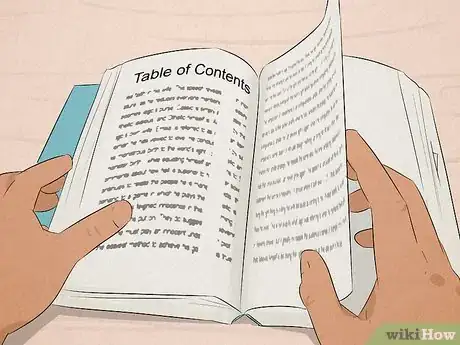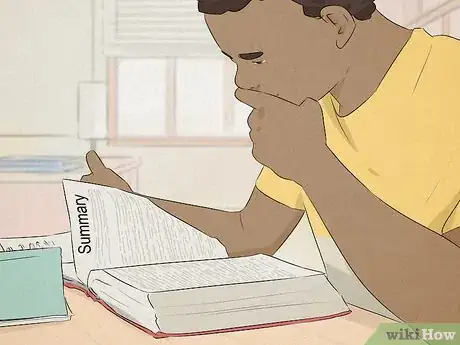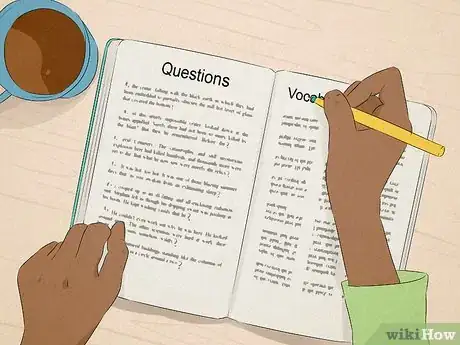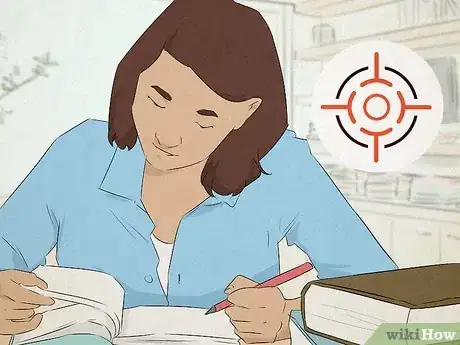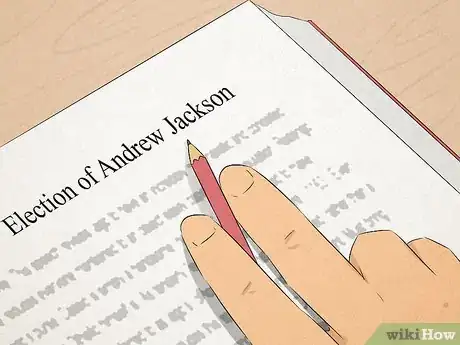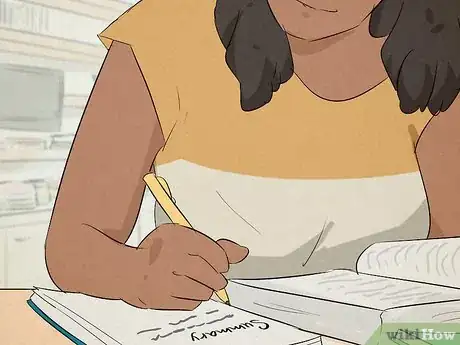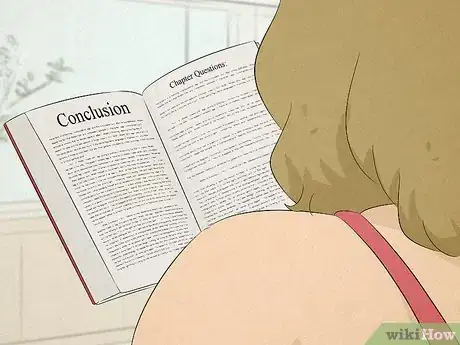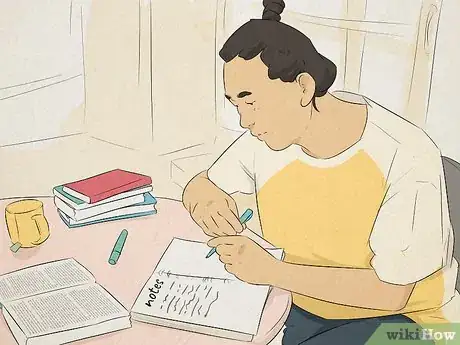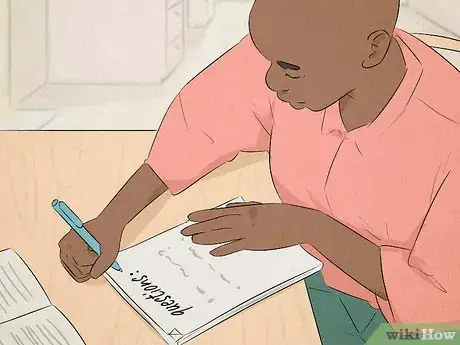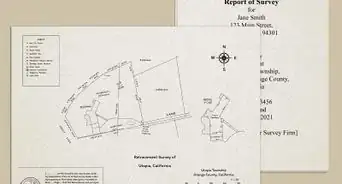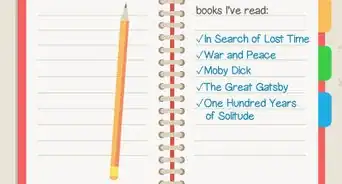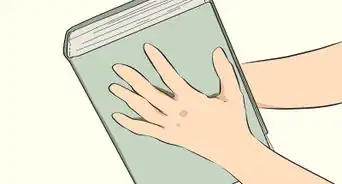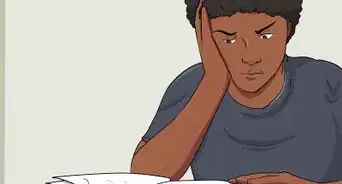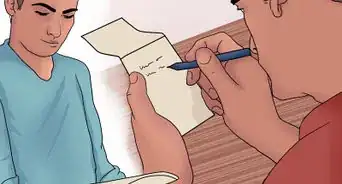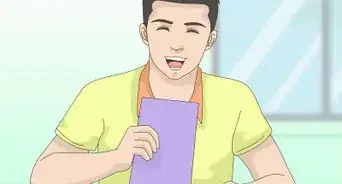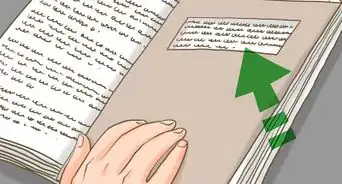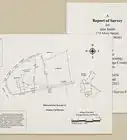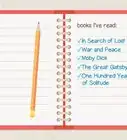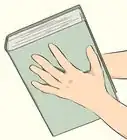This article was co-authored by Alexander Ruiz, M.Ed.. Alexander Ruiz is an Educational Consultant and the Educational Director of Link Educational Institute, a tutoring business based in Claremont, California that provides customizable educational plans, subject and test prep tutoring, and college application consulting. With over a decade and a half of experience in the education industry, Alexander coaches students to increase their self-awareness and emotional intelligence while achieving skills and the goal of achieving skills and higher education. He holds a BA in Psychology from Florida International University and an MA in Education from Georgia Southern University.
There are 8 references cited in this article, which can be found at the bottom of the page.
This article has been viewed 7,594 times.
Whether you’re in junior high, high school, or college, textbooks are probably a part of your history classes. This might be a little intimidating, since textbooks are big and packed with information. How can you possibly learn all that? Don’t worry! Textbooks are easier to read than you might think. They’re very straightforward and clear about the information you have to know. The best way to read a history textbook is by chapter, because each chapter has a clear point. With the right strategies, you can break down each chapter and learn everything you need to know.
Steps
Chapter Previews
-
1Skim the layout and contents at the beginning of the chapter. Most textbooks have a table of contents at the beginning of each chapter. This outlines the headings for each section, so you can tell where the chapter is going. Look at these headings and try to anticipate what this chapter will be all about.[1]
- There are usually clues in the chapter headings. For example, if a heading starts with “The Problem with…”, you can anticipate that this section will be about shortcomings or failures.
- If your textbook doesn’t have a table of contents for each chapter, check the book’s main contents section at the beginning. This might have a heading breakdown for each chapter.
-
2Read the chapter summary to get the chapter’s main idea. History textbooks usually have an introduction that summarizes the whole chapter. Even better, the introductions are usually only a few paragraphs long. This is a great way to get the main ideas for each chapter without needing to read a lot. Be sure to read this introduction carefully and write down the themes that the author says that they’ll cover.[2]
- Textbooks are very straightforward, so there won’t be any surprise twists or endings. This is why chapter introductions are important to read. The author will give a clear summary of what to expect, and the rest of the chapter fills in the details.
- If there isn’t a clear introduction section, try reading the first few paragraphs of the first section. There might be a chapter summary hidden in there.
Advertisement -
3Check the questions and vocabulary list at the end of the chapter. It might feel weird to flip right to the end of a chapter before reading it, but this is a key part of efficient reading. Textbooks usually have discussion questions and a list of vocabulary words at the end of each chapter. The questions usually outline the main chapter ideas, while the vocabulary words are the key terms you’ll need to know. Review both of these before even reading the chapter.[3]
- You don’t have to write down each question. But you should write down the key themes to look for in each question. For example, if a question says “What were the main reasons that the British lost the American Revolution?" you know that you should be looking for those reasons in the chapter.
- History textbooks usually have a lot of vocabulary words, so it’s a good idea to have a vocabulary section of your notebook where you jot down important terms. This way, all the vocabulary you need is in one place.
-
4Try to anticipate the author’s point for each chapter. Textbooks are a little different from regular history books, because the author isn’t necessarily proving an argument that they’ve researched. However, the author usually does have a specific point they’re trying to prove, and they often state it clearly in the chapter summary or conclusion. Look for a clear statement of the author’s point or angle, which is usually only 1 or 2 sentences, to tip you off about the chapter’s big idea.[4]
- The author’s point might be a clear statement, like “The outbreak of World War I showed that Europe’s diplomatic system had failed.” This tells you exactly what the author’s direction and conclusions are.
- The chapter title could also be a clue. If the title is “The Failure of the Roman Empire,” you know that the chapter is probably about problems, bad decisions, and defeats.
Efficient Reading Tricks
-
1Read each section heading for clues. It’s tempting to speed-read through all the section headings, but you’re missing out on key information if you do that. Textbook headings are usually written to tell you exactly what each section is about. This is a huge help and lets you predict the information you should have by the end of the section.[5]
- A heading might be something like “Abraham Lincoln and the Issue of Slavery.” That one heading tells you exactly what you’re about to read. By the end, you should know Abraham Lincoln’s stance on slavery.
- If another heading was "France's Defeat" in a chapter on World War II, it's clear that you'll get an explanation of France's failures in the war.
- Some keywords to look for in headings include success, failure, causes, results, effects, shortcomings, and tensions. These all tip you off to the section argument.
-
2Get the main idea by reading the first and last sentence of paragraphs. This is a classic reading trick that usually works very well for history textbooks. The first and last sentences of paragraphs usually sum up the entire paragraph and give you the main points. By reading these 2 sentences in each paragraph, you can get all the information you need without reading every word.[6]
- The first sentence of a paragraph might say "Despite some changing political opinions, Abraham Lincoln always opposed slavery." The conclusion might be "Lincoln's antislavery views stuck with him up until the Civil War." The middle part of the paragraph likely just elaborates on this point, so you don't have to read it.
- Don’t, however, keep doing this if you feel like you’re missing important information. If you’ve gone a few pages and realize you can’t remember what you just read, then slow down and read more than just intro and conclusion sentences.
-
3Write down any bold vocabulary words that you come across. Textbooks usually have a vocabulary list for each chapter, and these terms appear in bold throughout the text. These words are important for the chapter, so always write them down and define them. This way, you have a simple list of key terms to study from later.[7]
- If the term isn’t defined in the text, check the glossary in the back of the book for the definition.
- You may have already done this if you checked the end of the chapter for a vocabulary list. Not all textbooks have a list at the end of the chapter, though, so it’s good practice to write them down as you read.
-
4Skip the explanations for graphs or charts that are self-explanatory. History textbooks might have visual aids like graphs, timelines, or maps. Usually, the few paragraphs around these images provide an explanation for what they show. In a lot of cases, the images are self-explanatory and you don’t need to read the other text. This is a good way to read more quickly without losing any information.[8]
- For example, you might see a graph titled “Steel output in the United States, 1860-1920” showing a dramatic increase in steel production. The surrounding text might explain that steel production grew as part of America’s industrialization, but you already got that information from the graph.
- Timelines are another common graphic in history textbooks. This lays out all the major events you need to know, so you probably don't have to read much explanation about it.
- Don’t skip the written sections if you don’t understand the image, though. Sometimes you’ll need some more explanation to really get what’s going on.
-
5Stop and summarize what you read at the end of each section. It’s easy to lose focus while you’re reading, especially if you’re not interested in the subject. Keep yourself on track by stopping for a minute to summarize what you’ve read at the end of each section. If you can rattle off a few sentences about the content and conclusions about that section, you’re on the right track. If not, go back and review a bit more.[9]
- If you’re having trouble remembering what you’ve read, you might need to adjust your reading style. If you’re skipping around a lot, try going slower and reading whole paragraphs instead of just a few sentences.
- Writing things down in your own words can help make it easier to digest what you just read.[10]
- To remember what was in a passage you just read, write down your summary on a sticky note, then place the sticky note in the text next to that passage.[11]
-
6Finish the whole chapter to get all the information you need. While you can skip around and skim, you still have to go through the whole chapter. History textbook chapters are usually organized by topic, so you'll miss important information if you only read part of it. Use these skimming and reading techniques to get through the whole chapter and you won't miss anything.
- You don't have to read the whole chapter at once. If you're getting bored or have trouble paying attention, read the chapter in 10-page chunks so you don't tune out.[12]
- The only exception is if your teacher only assigns certain pages in a chapter. Then you can just stick to those pages.
Memory and Study Tips
-
1Take notes after each section instead of writing as you read. It’s tempting to write down all the important information as you come across it, but this can break your flow. Especially in a history textbook, there will be a ton of information, and not all of it is important. It’s best to hold off writing notes until you reach the end of a section. Then, while you’re summarizing it to yourself, write down important information like the section conclusion and supporting evidence.[13]
- Try to focus on the information that supports the section argument. If a section is titled “The Success of the New Deal,” look for information that proves the New Deal was a success for your notes.
- If you have any questions, write them down as well. For example, “Is the author ignoring something when they make this point?” is always a worthwhile question to ask if the textbook says that relations between Native Americans and European settlers were peaceful.
-
2Highlight and underline only key information. Rather than writing notes, underlining or highlighting information helps maintain your pace and keep you focused. However, resist the urge to highlight everything. This isn’t helpful. Instead, just underline the key points and information so you can scan pages and quickly find the key points while you’re reviewing.[14]
-
3Stop and look up any unfamiliar words or concepts. Since you’re learning a new subject, you’ll definitely come across words or concepts you’ve never heard of. While textbooks usually define these ideas in the text, they don’t always, and you might find it difficult to understand the rest of the chapter. If you have to, stop and look up what the term means in another part of the book or a dictionary. That way, you’ll know what the author means.[17]
- For example, your history textbook might use the term Manifest Destiny, but not highlight or define it. If you don’t know what this means, you might have trouble getting the author’s point. Look this up before moving on.
- Sometimes, a key term was defined in a different section of the book. Try checking the book’s glossary for the definition, or use the index to find the first mention of it.
- If you can’t find the definition for a term, don’t hesitate to ask your teacher.
-
4Jot down questions or doubts you have about the chapter. Critical reading means engaging with the text and asking questions. Whether you’re not sure about something or don’t agree with the author, always write down questions that come up while you’re reading. Then you can bring these questions up in class for discussion, or use them in an essay or test.[18]
- If you have questions because you don’t understand the text, then definitely ask your teacher for an explanation so you’re prepared for your assignments.
- Questions about the author’s conclusions, like whether they’re ignoring evidence, can be used for discussions or assignments. They show that you’ve critically engaged with the text.
Expert Q&A
Did you know you can get expert answers for this article?
Unlock expert answers by supporting wikiHow
-
QuestionShould I take notes when reading a textbook?
 Alexander Ruiz, M.Ed.Alexander Ruiz is an Educational Consultant and the Educational Director of Link Educational Institute, a tutoring business based in Claremont, California that provides customizable educational plans, subject and test prep tutoring, and college application consulting. With over a decade and a half of experience in the education industry, Alexander coaches students to increase their self-awareness and emotional intelligence while achieving skills and the goal of achieving skills and higher education. He holds a BA in Psychology from Florida International University and an MA in Education from Georgia Southern University.
Alexander Ruiz, M.Ed.Alexander Ruiz is an Educational Consultant and the Educational Director of Link Educational Institute, a tutoring business based in Claremont, California that provides customizable educational plans, subject and test prep tutoring, and college application consulting. With over a decade and a half of experience in the education industry, Alexander coaches students to increase their self-awareness and emotional intelligence while achieving skills and the goal of achieving skills and higher education. He holds a BA in Psychology from Florida International University and an MA in Education from Georgia Southern University.
Educational Consultant
-
QuestionWhat can I do to help remember what I read?
 Alexander Ruiz, M.Ed.Alexander Ruiz is an Educational Consultant and the Educational Director of Link Educational Institute, a tutoring business based in Claremont, California that provides customizable educational plans, subject and test prep tutoring, and college application consulting. With over a decade and a half of experience in the education industry, Alexander coaches students to increase their self-awareness and emotional intelligence while achieving skills and the goal of achieving skills and higher education. He holds a BA in Psychology from Florida International University and an MA in Education from Georgia Southern University.
Alexander Ruiz, M.Ed.Alexander Ruiz is an Educational Consultant and the Educational Director of Link Educational Institute, a tutoring business based in Claremont, California that provides customizable educational plans, subject and test prep tutoring, and college application consulting. With over a decade and a half of experience in the education industry, Alexander coaches students to increase their self-awareness and emotional intelligence while achieving skills and the goal of achieving skills and higher education. He holds a BA in Psychology from Florida International University and an MA in Education from Georgia Southern University.
Educational Consultant
References
- ↑ https://learningcenter.unc.edu/tips-and-tools/reading-textbooks-effectively/
- ↑ https://students.dartmouth.edu/academic-skills/learning-resources/learning-strategies/reading-techniques
- ↑ https://learningcenter.unc.edu/tips-and-tools/reading-textbooks-effectively/
- ↑ http://www.owlnet.rice.edu/~wcm1/howtoread.html
- ↑ https://students.dartmouth.edu/academic-skills/learning-resources/learning-strategies/reading-techniques
- ↑ https://learningcenter.unc.edu/tips-and-tools/reading-textbooks-effectively/
- ↑ https://www.cornellcollege.edu/academic-support-and-advising/academic-support/study-tips/reading-textbooks.shtml
- ↑ https://learningcenter.unc.edu/tips-and-tools/skimming/
- ↑ https://learningcenter.unc.edu/tips-and-tools/reading-textbooks-effectively/
- ↑ Alexander Ruiz, M.Ed.. Educational Consultant. Expert Interview. 4 August 2020
- ↑ Alexander Ruiz, M.Ed.. Educational Consultant. Expert Interview. 4 August 2020
- ↑ https://www.cornellcollege.edu/academic-support-and-advising/academic-support/study-tips/reading-textbooks.shtml
- ↑ http://www.owlnet.rice.edu/~wcm1/howtoread.html
- ↑ http://www.owlnet.rice.edu/~wcm1/howtoread.html
- ↑ Alexander Ruiz, M.Ed.. Educational Consultant. Expert Interview. 18 June 2020.
- ↑ https://www.cornellcollege.edu/academic-support-and-advising/academic-support/study-tips/reading-textbooks.shtml
- ↑ https://students.dartmouth.edu/academic-skills/learning-resources/learning-strategies/reading-techniques
- ↑ https://learningcenter.unc.edu/tips-and-tools/reading-textbooks-effectively/
- ↑ https://www.carleton.edu/history/resources/history-study-guides/read/readinghistory/
